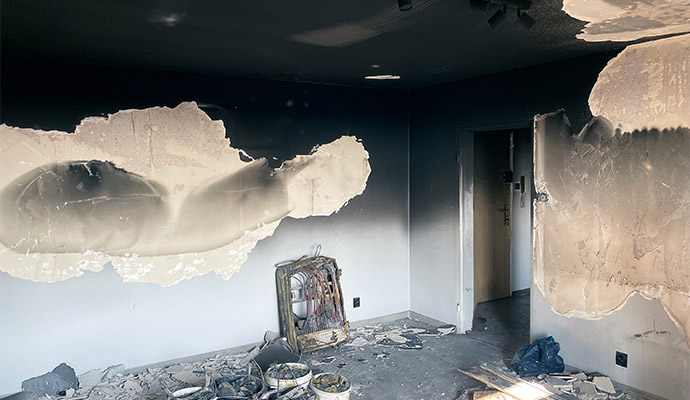How Do You Fix Smoke Damaged Walls?

Fires can be devastating to your home or business. A large fire can consume almost everything in the building, fueling itself with almost anything available: wood, paper, fabric, even metal under the right conditions.
However, even a small, contained fire can do a lot of damage to your home through its companion: smoke. Smoke can travel through your home, penetrating everything it contacts. Smoke damage can extend far beyond the area of the fire, and it can linger long after the fire is extinguished.
Here’s how to address smoke damaged walls in your home or business.
Clean Superficial Smoke Stains
After a small fire, you may have only one or a few walls that got superficial smoke damage. In this case, you can try cleaning the walls by hand on your own. If there is a significant buildup of soot on the wall, you can start with a dry-cleaning or soot sponge. You might be able to get these at your local hardware store. Use these to carefully blot away the soot. Only use each area of the sponge once, but you can cut it away to reveal a fresh surface when the entire sponge is blackened.
Once you’ve gotten the majority of the soot removed, you can clean with a warm solution of vinegar and water or a mild soap or detergent. Wash walls one small area at a time, working from the bottom up. Do the ceiling last. Rinse each area with clear water when finished, and let it dry thoroughly.
Note that walls may still be discolored. You can repaint after the wall is completely dry. If smoke odors remain, you can consider using primer designed to seal out odors.
For Serious Smoke-Damaged Walls
However, if your home or business was impacted by a serious fire, the odds are good that you will need professional help to deal with the smoke smell and the potentially toxic residue left by the fire both on surfaces and in the air.
If smoke damage occurred in several rooms and the fire burned for a while, even if it was just a low, smoldering fire, then you need to work with a fire damage restoration company who understands the complexity of smoke damage restoration.
Note that if you do an internet search for smoke odor and smoke damage home remedies, most of the results you get are talking about cigarette smoke, which is entirely different from the smoke created by a building fire. Although cigarette smoke exposure happens over months or years, allowing it to penetrate substances, it does not create either the amount or type of smoke that characterizes building fires.
Five Types of Smoke Damage
Part of the complexity and difficulty of dealing with smoke damage at your home or business is that there are potentially many types of smoke that can be created by the fire. Depending on the nature of the smoke, you might experience different toxic chemicals, odors, and sooty residues.
The most common categorization of smoke breaks it down into four or five types. Dealing with these different types of smoke damage requires different cleaning approaches. Fire damage restoration professionals understand the different types of smoke and how to address them.
1. Dry Smoke Damage
Dry smoke is created by fast-burning, high-temperature fires, such as those fueled by paper or wood, including wildfires. Even when these fires are outside your building, the fine ash and penetrating smoke can enter through cracks and porous materials.
2. Fuel Smoke Damage
Fuel smoke is generated by petroleum fuels, such as oil, gasoline, diesel fuels, and related materials. Fuel smoke is thick, and once it settles, it can turn into a greasy residue that can be very hard to remove from any surface, especially fabrics.
3. Protein Smoke damage
Protein smoke is produced by low-temperature kitchen fires, which consume food products, such as meats, vegetables, and cooking oils. Protein smoke can discolor paint; however, other than the pervasive smell, it can be easier to clean than other types of smoke.
4. Wet Smoke Damage
When plastics and rubber burns, it tends to create smoldering, low-temperature fires that create greasy black residue. This smoke is not only hard to remove from surfaces, but it can penetrate electronics and corrode the metals inside, leading to serious damage to the components.
5. Complex Smoke Damage
While most people agree on the previous four categories of smoke damage, some prefer to add a fifth category of smoke damage: complex. This type of smoke is created in building fires where multiple types of materials are consumed, creating smoke that has characteristics of all the other types as well as some of its own properties.
Fire Damage Restoration in the Spokane and Coeur d’Alene Areas
If you have smoke damaged walls in your home or business, let Burke’s Restoration assess the damage and determine the proper approach for repairing them. Since 2012, Burke’s has been serving the communities of the Spokane-Coeur d’Alene corridor with disaster restoration services. We offer 24/7 emergency response services, so we can be there to start the restoration process as soon as the fire department clears the building. We can handle every aspect of the fire damage restoration, including smoke damage and water damage related to the fire department’s response.
No matter the type of smoke you’re dealing with, we use the most advanced processes available in the industry to address them, eliminating the visible smoke residue as well as the smell. We’ll also coordinate with your insurance company. We can document all damage and take the proper steps to ensure your insurance company has all the information they need to promptly pay your claim to the full extent of your coverage.
To get help with your smoke damaged walls in Spokane, Coeur d’Alene and anyplace in between, please contact Burke’s Restoration today.





